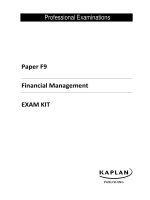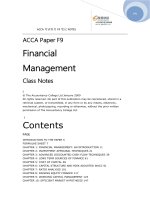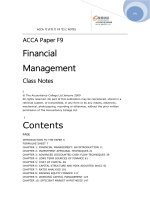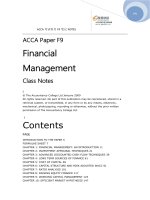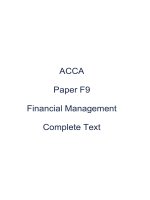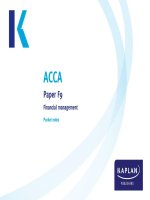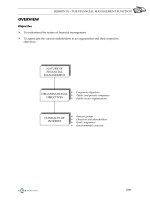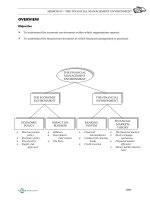Dani Ali Tech ACCA PAPER F9 FINANCIAL MANAGEMENT
Bạn đang xem bản rút gọn của tài liệu. Xem và tải ngay bản đầy đủ của tài liệu tại đây (7.79 MB, 532 trang )
Maximise Your Exam Success with BPP Learning Media’s
Platinum Approved Materials
LEARN
Our Study Texts are the only Texts that have been reviewed by the examiner. This ensures that our coverage of the
syllabus is appropriate for your exam. By choosing our Platinum Approved Study Text you are one step nearer to
achieving the exam success you deserve.
PRACTISE AND APPLY
Our Practice & Revision Kits are the only Kits that have been reviewed by the examiner. Use our Kits and our i-Pass
CD-ROMs to reinforce and apply your knowledge. Kits are packed with past ACCA exam questions together with
full solutions and handy tutor’s hints.
i-Pass contains approximately 300 questions, covering all important syllabus areas.
REVISE AND RETAIN
Revise using our pocket-sized Passcards and then listen to our audio Success CD to give your revision a boost.
Our Interactive Passcards product takes the Passcards, adds additional tutorials, comments and lots of testing and links
them to the Study Text. The result is a truly interactive revision experience. Revise using the on-screen Passcards and
dip into the on-screen Study Text for more detail.
BPP LEARNING MEDIA CUSTOMER SERVICES
Te l : 0845 075 1100 (UK) Email:
Te l : +44 (0)20 8740 2211 (Overseas) Website: www.bpp.com/learningmedia
To help maximise your chances of passing, we’ve put together
some exclusive additional ACCA resources. To access the BPP
ACCA online additional resources for this material please go to:
/>n
Create a user account if you don’t already have one.
Make sure you reply to the confirmation email.
n
Log in using your registered username and password.
Select the paper you wish to access.
n
Enter the code below when prompted. You will only have
to do this once for each paper you are studying.
ACCA Platinum Text IFC & IBC 2011 (for DIGITAL prints)_Layout 1 13/10/2011 12:28 Page 1
S
T
U
D
Y
T
E
X
T
PAPER F9
FINANCIAL MANAGEMENT
BPP Learning Media is the sole ACCA Platinum Approved Learning Partner – content
for the ACCA qualification. In this, the only Paper P1 study text to be reviewed by the
examiner:
We discuss the best strategies for studying for ACCA exams
We highlight the most important elements in the syllabus and the key skills you will need
We signpost how each chapter links to the syllabus and the study guide
We provide lots of exam focus points demonstrating what the examiner will want you to do
We emphasise key points in regular fast forward summaries
We test your knowledge of what you've studied in quick quizzes
We examine your understanding in our exam question bank
We reference all the important topics in our full index
BPP's Practice & Revision Kit, i-Pass and Interactive Passcard products also
support this paper.
FOR EXAMS UP TO JUNE 2014
ii
First edition 2007
Sixth edition September 2012
ISBN 9781 4453 9652 1
(Previous ISBN 9781 4453 7766 7)
e-ISBN 9781 4453 9212 7
British Library Cataloguing-in-Publication Data
A catalogue record for this book
is available from the British Library
Published by
BPP Learning Media Ltd
BPP House, Aldine Place
London W12 8AA
www.bpp.com/learningmedia
Printed in the United Kingdom by
Polestar Wheatons
Hennock Road
Marsh Barton
Exeter
EX2 8RP
Your learning materials, published by BPP Learning
Media Ltd, are printed on paper obtained from
traceable sustainable sources.
All our rights reserved. No part of this publication may be
reproduced, stored in a retrieval system or transmitted, in
any form or by any means, electronic, mechanical,
photocopying, recording or otherwise, without the prior
written permission of BPP Learning Media Ltd.
We are grateful to the Association of Chartered Certified
Accountants for permission to reproduce past
examination questions. The suggested solutions in the
exam answer bank have been prepared by BPP Learning
Media Ltd, unless otherwise stated.
©
BPP Learning Media Ltd
2012
Contents
iii
Contents
Page
Introduction
Helping you to pass – the ONLY F9 Study Text reviewed by the examiner! v
Studying F9 vii
The exam paper and exam formulae x
Part A Financial management function
1 Financial management and financial objectives 3
Part B Financial management environment
2 The economic environment for business 35
3 Financial markets and institutions 55
Part C Working capital management
4 Working capital 75
5 Managing working capital 89
6 Working capital finance 115
Part D Investment appraisal
7 Investment decisions 139
8 Investment appraisal using DCF methods 155
9 Allowing for inflation and taxation 173
10 Project appraisal and risk 187
11 Specific investment decisions 201
Part E Business finance
12 Sources of finance 221
13 Dividend policy 253
14 Gearing and capital structure 263
Part F Cost of capital
15 The cost of capital 285
16 Capital structure 309
Part G Business valuations
17 Business valuations 329
18 Market efficiency 351
Part H Risk management
19 Foreign currency risk 363
20 Interest rate risk 387
Mathematical tables
401
Exam question bank
405
Exam answer bank
427
Index
485
Review form
iv
A note about copyright
Dear Customer
What does the little © mean and why does it matter?
Your market-leading BPP books, course materials and elearning materials do not write and update
themselves. People write them: on their own behalf or as employees of an organisation that invests in this
activity. Copyright law protects their livelihoods. It does so by creating rights over the use of the content.
Breach of copyright is a form of theft – as well being a criminal offence in some jurisdictions, it is
potentially a serious breach of professional ethics.
With current technology, things might seem a bit hazy but, basically, without the express permission of
BPP Learning Media:
Photocopying our materials is a breach of copyright
Scanning, ripcasting or conversion of our digital materials into different file formats, uploading
them to facebook or emailing them to your friends is a breach of copyright
You can, of course, sell your books, in the form in which you have bought them – once you have finished
with them. (Is this fair to your fellow students? We update for a reason.) But the e-products are sold on a
single user licence basis: we do not supply ‘unlock’ codes to people who have bought them second hand.
And what about outside the UK? BPP Learning Media strives to make our materials available at prices
students can afford by local printing arrangements, pricing policies and partnerships which are clearly
listed on our website. A tiny minority ignore this and indulge in criminal activity by illegally photocopying
our material or supporting organisations that do. If they act illegally and unethically in one area, can you
really trust them?
Introduction
v
Helping you to pass – the ONLY F9 Study Text reviewed
by the examiner!
BPP Learning Media – the sole Platinum
Approved Learning Partner - content
As ACCA’s sole Platinum Approved Learning Partner – content, BPP Learning Media gives you the
unique opportunity to use examiner-reviewed study materials for the 2013 exams. By incorporating the
examiner’s comments and suggestions regarding the depth and breadth of syllabus coverage, the BPP
Learning Media Study Text provides excellent, ACCA-approved support for your studies.
The PER alert
Before you can qualify as an ACCA member, you do not only have to pass all your exams but also fulfil a
three year practical experience requirement (PER). To help you to recognise areas of the syllabus that
you might be able to apply in the workplace to achieve different performance objectives, we have
introduced the ‘PER alert’ feature. You will find this feature throughout the Study Text to remind you that
what you are learning to pass your ACCA exams is equally useful to the fulfilment of the PER
requirement.
Tackling studying
Studying can be a daunting prospect, particularly when you have lots of other commitments. The
different features of the text, the purposes of which are explained fully on the Chapter features page, will
help you whilst studying and improve your chances of exam success.
Developing exam awareness
Our Texts are completely focused on helping you pass your exam.
Our advice on Studying F9 outlines the content of the paper, the necessary skills the examiner expects
you to demonstrate and any brought forward knowledge you are expected to have.
Exam focus points are included within the chapters to highlight when and how specific topics were
examined, or how they might be examined in the future.
Using the Syllabus and Study Guide
You can find the syllabus and Study Guide on page xi of this Study Text.
Testing what you can do
Testing yourself helps you develop the skills you need to pass the exam and also confirms that you can
recall what you have learnt.
We include Questions – lots of them - both within chapters and in the Exam Question Bank, as well as
Quick Quizzes at the end of each chapter to test your knowledge of the chapter content.
vi
Introduction
Chapter features
Each chapter contains a number of helpful features to guide you through each topic.
Topic list
Topic list Syllabus reference
What you will be studying in this chapter and the relevant
section numbers, together the ACCA syllabus references.
Introduction
Puts the chapter content in the context of the syllabus as
a whole.
Study Guide
Links the chapter content with ACCA guidance.
Exam Guide
Highlights how examinable the chapter content is likely to
be and the ways in which it could be examined.
Knowledge brought forward from earlier studies
What you are assumed to know from previous
studies/exams.
Summarises the content of main chapter headings,
allowing you to preview and review each section easily.
Examples
Demonstrate how to apply key knowledge and
techniques.
Key terms
Definitions of important concepts that can often earn you
easy marks in exams.
Exam focus points
When and how specific topics were examined, or how
they may be examined in the future.
Formula to learn
Formulae that are not given in the exam but which have to
be learnt.
Gives you a useful indication of syllabus areas that
closely relate to performance objectives in your Practical
Experience Requirement (PER).
Question
Gives you essential practice of techniques covered in the
chapter.
Case Study
Real world examples of theories and techniques.
Chapter Roundup
A full list of the Fast Forwards included in the chapter,
providing an easy source of review.
Quick Quiz
A quick test of your knowledge of the main topics in the
chapter.
Exam Question Bank
Found at the back of the Study Text with more
comprehensive chapter questions. Cross referenced for
easy navigation.
FA
S
T F
O
RWAR
D
Introduction
vii
Studying F9
This paper examines a wide range of financial management topics, many of which will be completely new
to you. You will need to be competent at a range of quite tricky calculations as well as able to explain and
discuss financial management techniques and issues.
The F9 examiner
The examiner is Tony Head. He expects you to be able to perform and comment on calculations, exercise
critical abilities, clearly demonstrate understanding of the syllabus and use question information.
Syllabus update
The F9 syllabus has been updated for the June 2013 sitting onwards. The syllabus changes are
summarised below.
Summary of changes to F9
ACCA periodically reviews its qualification syllabuses so that they fully meet the needs of stakeholders
such as employers, students, regulatory and advisory bodies and learning providers.
The changes to the F9 syllabus are summarised below. The additions to the syllabus consist of two topics
previously examined in the higher-level P4 paper which are now included at the F9 level. There are also
two topics which have been deleted, as they will be assumed knowledge from F2 and FMA.
Table 1 – Additions to F9
Section and subject area Syllabus content
B3 – The treasury function (a) Describe the role of money markets in:
(i) Providing short-term liquidity to
industry and the public sector
(ii) Providing short-term trade finance
(iii) Allowing an organisation to
manage its exposure to foreign
currency risk and interest rate risk
(b) Explain the role of banks and other
financial institutions in the operation of
the money markets.
(c) Explain the characteristics and role of
the principal money market
instruments:
(i) Interest-bearing instruments
(ii) Discount instruments
(iii) Derivative products.
F2 – Estimating the cost of equity (b) Explain and discuss systematic and
unsystematic risk, and the relationship
between portfolio theory and the capital
asset pricing model (CAPM)
viii
Introduction
Table 2 – Deletion from F9
Section and subject area Syllabus content
D1 – The nature of investment decisions and
the appraisal process
(a) Distinguish between capital and revenue
expenditure, and between non-current
assets and working capital investment.
(b) Explain the role of investment appraisal
in the capital budgeting process.
(c) Discuss the stages of the capital
budgeting process in relation to
corporate strategy.
D3 – Discounted cash flow (DCF) techniques (a) Explain and apply concepts relating to
interest and discounting, including:
(i) The relationship between interest
rates and inflation, and between
real and nominal interest rates
(ii) The calculation of future values and
the application of the annuity
formula
(iii) The calculation of present values,
including the present value of an
annuity and perpetuity, and the use
of discount and annuity tables
(iv) The time value of money and the
role of cost of capital in appraising
investments
Introduction
ix
1 What F9 is about
The aim of this syllabus is to develop the knowledge and skills expected of a finance manager, in relation
to investment, financing and dividend policy decisions.
F9 is a middle level paper in the ACCA qualification structure. There are some links to material you have
covered in F2, particularly short-term decision making techniques. The paper with a direct link following
F9 is P4 which thinks strategically and considers wider environmental factors. F9 requires you to be able
to apply techniques and think about their impact on the organisation.
2 What skills are required?
You are expected to have a core of financial management knowledge
You will be required to carry out calculations, with clear workings and a logical structure
You will be required to explain financial management techniques and discuss whether they are
appropriate for a particular organisation
You must be able to apply your skills in a practical context
3 How to improve your chances of passing
There is no choice in this paper, all questions have to be answered
You must therefore study the entire syllabus, there are no short-cuts
Practising questions under timed conditions is essential. BPP’s Practice and Revision Kit
contains 25 mark questions on all areas of the syllabus
Questions will be based on simple scenarios and answers must be focused and specific to the
organisation
Answer all parts of the question. Even if you cannot do all of the calculation elements, you will still
be able to gain marks in the discussion parts
Make sure you write full answers to discussion sections, not one or two word lists, the examiner is
looking for understanding to be demonstrated
Plan your written answers and write legibly
Include all your workings and label them clearly
Read Student Accountant (the ACCA’s student magazine) regularly – it often contains technical
articles written either by or on the recommendation of the examiner which can be invaluable for
future exams.
4 Brought forward knowledge
You will need to have a good working knowledge of certain management accounting techniques from F2.
In particular, short-term decision making techniques such as cost-volume-profit analysis and the
calculation of relevant costs. Due to the latest syllabus change, you will also need to be familiar with the
capital budgeting process, and be able to apply the concepts of interest and discounting. This includes
being able to calculate annuities and perpetuities, and to use the discount and annuity tables to calculate
net present values.
This Study Text revises these topics and brought forward knowledge is identified. Revision sections
around the capital budgeting process and interest and discounting are included in this Study Text. If you
struggle with the examples and questions used, you must go back and revisit your previous work. The
examiner will assume you know this material and it may form part of an exam question.
x
Introduction
The exam paper
Format of the paper
The exam consists of four compulsory 25 mark questions.
Time allowed is 3 hours with 15 minutes’ reading time.
Introduction
xi
Syllabus and Study Guide
The F9 syllabus and study guide can be found below.
xii
Introduction
Introduction
xiii
xiv
Introduction
Introduction
xv
xvi
Introduction
Introduction
xvii
xviii
Introduction
Introduction
xix
xx
Introduction
Analysis of past papers
The table below provides details of when each element of the syllabus has been examined and the
question number and section in which each element appeared. Further details can be found in the Exam
Focus Points in the relevant chapters.
Covered
in Text
chapter
June
2012
Dec
2011
June
2011
Dec
2010
June
2010
Dec
2009
June
2009
Dec
2008
Pilot
Paper
FINANCIAL MANAGEMENT FUNCTION
1 Nature & purpose
4c
1 Objectives 3a 4c,d 3a 3a,b 4a
1 Stakeholders 4a 1e
FINANCIAL MANAGEMENT ENVIRONMENT
2 Economic environment
3 Financial markets and institutions 4a
WORKING CAPITAL MANAGEMENT
4, 5 Management 2a,c 2a-d
3a,b,
c,d
1a,b,c 4b,d 3c 2b,c 3a,b,c
6 Funding strategies 2b 4b 4c 3a,b 3d
INVESTMENT APPRAISAL
7 Non-discounted cash flow techniques 1b 1b 2a,b 4b
8, 9 Discounted cash flow techniques 1a 1a,b 1a,b 1a 3a,b 1a,b 2b,c 3b 4a,c
10 Risk and uncertainty 1c 1c
11 Specific investment decisions 1c 1d 3c 1c,d
BUSINESS FINANCE
12 Sources of short-term finance 4a
12 Sources of long term-finance 3b,c 4a,b 3b 2a,b 2d 4b,c 1a, 4a
13 Dividend policy 3c 4d 4c 2d
14 Finance for SMEs
COST OF CAPITAL
15 Calculation 4c,d 3c 2a
1c,
4b,c
2a 2a,b,c 1a 3a 1a
16 Gearing (capital structure) 3d 2c 2b,c 1c 3c 1b,c
BUSINESS VALUATIONS
17 Valuation of shares 4a,b 3a,b 4a 4b 1b 1b,c,d
17 Valuation of debt 2b 4b
18
Efficient market hypothesis / practical
considerations
2c
RISK MANAGEMENT
19
Causes of interest rate / exchange rate
fluctuations
4a 3c 2b
19 Hedging foreign currency risk 3d,e 3d 4c,d 2a,c,d
20 Hedging interest rate risk 2a
Introduction
xxi
Exam formulae
Set out below are the formulae you will be given in the exam. If you are not sure what the symbols
mean, or how the formulae are used, you should refer to the appropriate chapter in this Study Text.
Chapter in
Study Text
Economic Order Quantity 5
=
0
2C D
Ch
Miller-Orr Model
6
Return point = Lower limit + (
1
3
spread)
Spread = 3
1
3
3
transaction cos t variance of cash flows
4
int erest rate
The Capital Asset Pricing Model
15
E(r
i
) = R
f
+ ß
i
(E (r
m
) – R
f
)
The Asset Beta Formula
16
ß
a
=
V
e
e
(V V (1 T))
e
d
+
V(1 T)
d
d
(V V (1 T))
e
d
The Growth Model
15
P
0
=
D(1 g)
0
(K g)
e
or P
0
=
D(1 g)
0
(r g)
e
Gordon’s Growth Approximation
15
g = br
e
The weighted average cost of capital
15
WACC =
V
e
VV
e
d
k
e
+
V
d
VV
e
d
k
d
(1–T)
The Fisher formula
9
(1 + i) = (1 + r)(1 + h)
Purchasing Power Parity and Interest Rate Parity
19
S
1
= S
0
(1 h )
c
(1 h )
b
F
0
= S
0
(1 i )
c
(1 i )
b
xxii
Introduction


